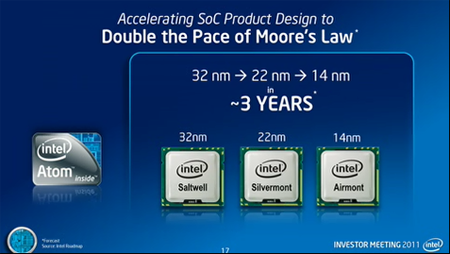Intel: We have ARM license, no plans to use it

The first question at a Q&A session during Intel's investor day today was predictably about ARM. CEO Paul Otellini quickly dismissed the idea that Intel would develop a processor using ARM cores, the technology behind the processors in the vast majority of tablets and smartphones.
Otellini noted that Intel already has an architectural license, which allows it to design processors from the ground up using ARM's architecture and instruction set. But Intel executives said that its own 32nm Atom processor, known as Medfield, already meets the stringent power requirements of smartphones. Furthermore, Otellini argued, building a good platform for mobile isn't really about the core but "all the other stuff around it" that makes a good SOC, or system-on-chip. Finally, joining the many companies designing ARM-based chips wouldn't guarantee Intel a spot in smartphones and it may not profitable either.
"So the short answer is, ‘No, we have no intention of using our own license to build ARM processors,'" Otellini said.
Instead Intel is making a bet that in the long run its silicon process technology and manufacturing capabilities will give it an edge over the many fabless chip companies that design ARM SOCs and rely on foundries to manufacture them. Intel's Atom processors have been stuck on 45nm process technology for years, but now the company seems serious about speeding up development. As I mentioned in my previous post, Intel confirmed that within the next three years it will ship new Atom SOCs on 32nm (Saltwell), 22nm (Silvermont) and 14nm (Airmont).
In addition, Otellini said Atom would scale in terms of power consumption both down into cell phones and up into other devices such as specialized servers. This combined with lower-power Core microprocessors for PCs, starting with Ivy Bridge in late 2011, will create a continuum of processors, in terms of power, to compete with ARM and others such as MIPS in all types of devices.
Recently, ARM executives have been trying to convince AMD to develop an ARM-based processor as a way to expand into tablets and smartphones. But it now looks like AMD has put the decision on ARM "on hold" until the company finds a new CEO.
